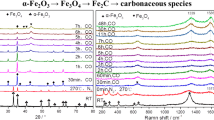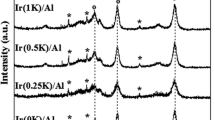Abstract
Thermal stability is one of the most important indexes determining the practical applications of selective catalytic reduction (SCR) catalysts. The influence of typical alkali element on the thermal stability of industrial V2O5-WO3/TiO2 catalyst is first reported in this work. The activity of the sample is measured, and physicochemical properties are characterized by X-ray diffraction (XRD), Fourier transform infrared spectroscopy (FTIR), Raman spectrum, field emission scanning electron microscope (FE-SEM), N2 adsorption-desorption, temperature programmed desorption of NH3 (NH3-TPD), and in situ diffuse reflectance infrared Fourier transform spectroscopy (in situ DRIFTS). The sintering and anatase-to-rutile phase transformation at high temperature will cause deactivation of SCR catalyst, and low concentration of K can increase the thermal stability. Under the same thermal treatment, the activity (380 °C) of sample deposited by K is more than three times higher than that of the fresh sample without K. Aggregation of vanadia in conventional SCR catalyst favors the sintering and anatase-to-rutile phase transformation of catalysts. Incorporation of K can modify the structure of partial V-OH and form V-OK, which hinders the aggregation of vanadia species and further increases the thermal stability of catalysts.

ᅟ









Similar content being viewed by others
References
Bulushev, D. A., Rainone, F., Kiwi-Minsker, L., & Renken, A. (2001). Influence of potassium doping on the formation of vanadia species in V/Ti oxide catalysts. Langmuir, 17(17), 5276–5282.
Casanova, M., Rocchini, E., Trovarelli, A., Schermanz, K., & Begsteiger, I. (2006). High-temperature stability of V2O5/TiO2-WO3-SiO2 SCR catalysts modified with rare-earths. Journal of Alloys and Compound, 408–412, 1108–1112.
Casanova, M., Schermanz, K., Llorca, J., & Trovarelli, A. (2012). Improved high temperature stability of NH3-SCR catalysts based on rare earth vanadates supported on TiO2-WO3-SiO2. Catalysis Today, 184(1), 227–236.
Chen, L., Li, J. H., & Ge, M. F. (2011). The poisoning effect of alkali metals doping over nano V2O5-WO3/TiO2 catalysts on selective catalytic reduction of NO x by NH3. Chemical Engineering Journal, 170(2–3), 531–537.
Cheng, K., Liu, J., Zhang, T., Li, J. M., Zhao, Z., Wei, Y. C., Jiang, G. Y., & Duan, A. J. (2014). Effect of Ce doping of TiO2 support on NH3-SCR activity over V2O5-WO3/CeO2-TiO2 catalyst. Journal of Environmental Sciences, 26(10), 2106–2113.
Choo, S. T., Yim, S. D., Nam, I.-S., Ham, S.-W., & Lee, J.-B. (2003). Effect of promoters including WO3 and BaO on the activity and durability of V2O5/sulfated TiO2 catalyst for NO reduction by NH3. Applied Catalysis B: Environmental, 44(3), 237–252.
Choung, J. W., Nam, I.-S., & Ham, S.-W. (2006). Effect of promoters including tungsten and barium on the thermal stability of V2O5/sulfated TiO2 catalyst for NO reduction by NH3. Catalysis Today, 111(3–4), 242–247.
Cristallo, G., Roncari, E., Rinaldo, A., & Trifirò, F. (2001). Study of anatase-rutile transition phase in monolithic catalyst V2O5/TiO2 and V2O5-WO3/TiO2. Applied Catalysis A: General, 209(1–2), 249–256.
Du, X. S., Gao, X., Qiu, K. Z., Luo, Z. Y., & Cen, K. F. (2015). The reaction of poisonous alkali oxides with vanadia SCR catalyst and the afterward influence: a DFT and experimental study. Journal of Physical Chemistry C, 119(4), 1905–1912.
Fu, M. F., Li, C. T., Lu, P., Qu, L., Zhang, M. Y., Zhou, Y., Yu, M. G., & Fang, Y. (2014). A review on selective catalytic reduction of NO x by supported catalysts at 100–300 °C—catalysts, mechanism, kinetics. Catalysis of Science & Technology, 4, 14–25.
Kamata, H., Takahashi, K., & Odenbrand, C. U. I. (1999). The role of K2O in the selective reduction of NO with NH3 over a V2O5(WO3)/TiO2 commercial selective catalytic reduction catalyst. Journal of Molecular Catalysis A, 139(2–3), 189–198.
Lietti, L., Ramis, G., Berti, F., Toledo, G., Robba, D., Busca, G., & Forzatti, P. (1998). Chemical, structural and mechanistic aspects on NO x SCR over commercial and model oxide catalysts. Catalysis Today, 42(1–2), 101–116.
Madia, G., Elsener, M., Koebel, M., Raimondi, F., & Wokaun, A. (2002). Thermal stability of vanadia-tungsta-titania catalysts in the SCR process. Applied Catalysis B: Environmental, 39(2), 181–190.
Miao, L., Tanemura, S., Toh, S., Kaneko, K., & Tanemura, M. (2004). Heating-sol–gel template process for the growth of TiO2 nanorods with rutile and anatase structure. Applied Surface Science, 238(1–4), 175–179.
Nova, I., Acqua, L., Lietti, L., Giamello, E., & Forzatti, P. (2001). Study of thermal deactivation of a de-NO x commercial catalyst. Applied Catalysis B: Environmental, 35(1), 31–42.
Odenbrand, C. U. I. (2008). Thermal stability of vanadia SCR catalysts for the use in diesel applications. Chemical Engineering Research and Design, 86(7), 663–672.
Pan, Y. X., Zhao, W., Zhong, Q., Cai, W., & Li, H. Y. (2013). Promotional effect of Si-doped V2O5/TiO2 for selective catalytic reduction of NO x by NH3. Journal of Environmental Sciences, 25(8), 1703–1711.
Peng, Y., Li, J. H., Shi, W. B., & Hao, J. M. (2012). Design strategies for development of SCR catalyst: improvement of alkali poisoning resistance and novel regeneration method. Environmental Science & Technology, 46(22), 12623–12629.
Shi, A. J., Wang, X. Q., Yu, T., & Shen, M. Q. (2011). The effect of zirconia additive on the activity and structure stability of V2O5/WO3-TiO2 ammonia SCR catalysts. Applied Catalysis B: Environmental, 106(3–4), 359–369.
Vargas, M. A. L., Casanova, M., Trovarelli, A., & Busca, G. (2007). An IR study of thermally stable V2O5-WO3-TiO2 SCR catalysts modified with silica and rare-earths (Ce, Tb, Er). Applied Catalysis B: Environmental, 75(3–4), 303–311.
Xu, C., Liu, J., Zhao, Z., Yu, F., Cheng, K., Wei, Y. C., Duan, A. J., & Jiang, G. Y. (2015). NH3-SCR denitration catalyst performance over vanadium-titanium with the addition of Ce and Sb. Journal of Environmental Sciences, 31, 74–80.
Yu, Y. K., Wang, J. X., Chen, J. S., Meng, X. R., Chen, Y. T., & He, C. (2014). Promotive effect of SO2 on the activity of a deactivated commercial selective catalytic reduction catalyst: an in situ DRIFT study. Industrial and Engineering Chemistry Research, 53(42), 16229–16234.
Zhang, S. L., & Zhong, Q. (2013). Promotional effect of WO3 on O2 − over V2O5/TiO2 catalyst for selective catalytic reduction of NO with NH3. Journal of Molecular Catalysis A, 373, 108–113.
Zhang, X. Y., Shen, Q., He, C., Ma, C. Y., Cheng, J., Li, L. D., & Hao, Z. P. (2012). Investigation of selective catalytic reduction of N2O by NH3 over an Fe-mordenite catalyst: reaction mechanism and O2 effect. ACS Catalysis, 2(4), 512–520.
Zheng, Y. J., Jensen, A. D., & Johnsson, J. E. (2004). Laboratory investigation of selective catalytic reduction catalysts: deactivation by potassium compounds and catalyst regeneration. Industrial and Engineering Chemistry Research, 43(4), 941–947.
Acknowledgments
This work is financially supported by the Bureau of Science and Technology, Fujian Province, China (2015H0043); the Strategic Priority Research Program of the Chinese Academy of Sciences (XDB05050500); the program of Innovation Team of the Bureau of Ningbo Science and Technology, China (2011B82003); and National Natural Science Foundation (21403210).
Author information
Authors and Affiliations
Corresponding authors
Rights and permissions
About this article
Cite this article
Yu, Y., Meng, X., Chen, J. et al. New Insight into the Effect of Potassium on Commercial SCR Catalyst: Promotion of Thermal Stability. Water Air Soil Pollut 226, 410 (2015). https://doi.org/10.1007/s11270-015-2677-y
Received:
Accepted:
Published:
DOI: https://doi.org/10.1007/s11270-015-2677-y




